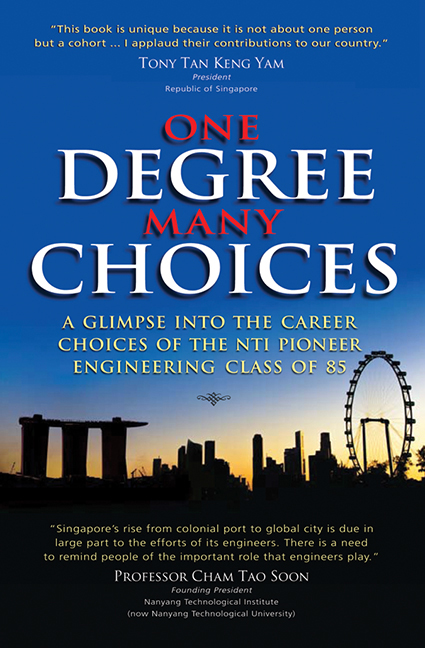 One Degree, Many Choices
One Degree, Many Choices from PART II - ENGINEERING PURSUITS
Published online by Cambridge University Press: 21 October 2015
“Our knowledge of thermodynamics and fluid mechanics was useful when it came to boilers and turbines.”
— Martinn Ho Yuen Liung, MPE PioneerTHE STENCH WAS OVERPOWERING and Martinn Ho Yuen Liung felt like vomiting. Fresh out of NTI, he had just started work at the Ulu Pandan refuse incineration plant. There was a mechanical failure and the giant travelling crane could not clear the garbage. His mechanical engineering training came to the rescue. “My knowledge of automation technology came in handy,” said Martinn. The fault was a worn-out limit switch. He solved the problem and enabled the refuse trucks to unload the refuse speedily.
Joining Martinn at the Ministry of Environment were Beck Choon Hueei, Lee Kheng Seng, Ong Chin Soon, Pang Fook Chong and Tan Kong Seng. They cut their teeth as shift engineers at the Ulu Pandan plant. With a team of technical personnel under them, they were responsible for the operation and maintenance of the entire incineration cum power generation plant. Under their care were auxiliary equipment such as instrumentation equipment, water treatment plants, pollution control equipment, air conditioning plants, conveyor systems and elevators. Their work required them to innovate to solve engineering problems. Martinn said, “NTI taught us thermodynamics and fluid mechanics. That enabled us to understand the way boilers and turbines work.”
Due to land shortage, incineration is the most viable form of waste disposal in Singapore. The process produces superheated steam to generate electricity, which in turn is used to operate the plant. Excess electricity is sold to the public utility network to generate income.
The NTI pioneers know all the waste disposal facilities in Singapore well. When the Tuas Incineration Plant opened in 1986, it used modern equipment and automation. Ong Chin Soon and Pang Fook Chong worked there. Tan Kong Seng is currently the General Manager at the plant. In 1992, the Senoko Incineration Plant was commissioned. Chin Soon helped to set it up. The latest plant is the Tuas South Incineration Plant which began operations in 2000. Fook Chong is the Senior Manager there. After the first incineration plant at Ulu Pandan was shut down in 2009 and the government divested Senoko plant in a sale to Keppel Group, Chin Soon moved to the Tuas Marine Transfer Station as Senior Manager. This station is the collection point for ash from waste-to-energy plants and non-incinerable waste.
To save this book to your Kindle, first ensure no-reply@cambridge.org is added to your Approved Personal Document E-mail List under your Personal Document Settings on the Manage Your Content and Devices page of your Amazon account. Then enter the ‘name’ part of your Kindle email address below. Find out more about saving to your Kindle.
Note you can select to save to either the @free.kindle.com or @kindle.com variations. ‘@free.kindle.com’ emails are free but can only be saved to your device when it is connected to wi-fi. ‘@kindle.com’ emails can be delivered even when you are not connected to wi-fi, but note that service fees apply.
Find out more about the Kindle Personal Document Service.
To save content items to your account, please confirm that you agree to abide by our usage policies. If this is the first time you use this feature, you will be asked to authorise Cambridge Core to connect with your account. Find out more about saving content to Dropbox.
To save content items to your account, please confirm that you agree to abide by our usage policies. If this is the first time you use this feature, you will be asked to authorise Cambridge Core to connect with your account. Find out more about saving content to Google Drive.